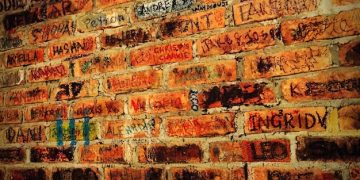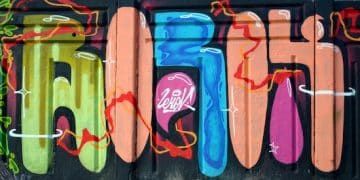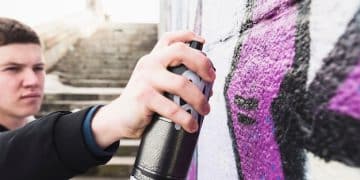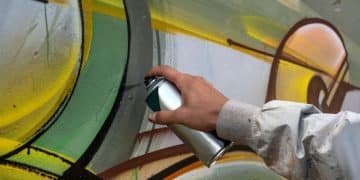Graffiti Art vs. Vandalism: Legal Distinctions in the US
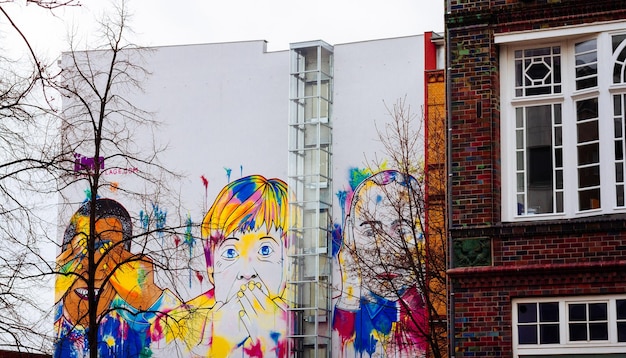
Graffiti art and vandalism, while visually similar, are legally distinct in the US, with their classification depending on property owner consent and intent, profoundly impacting legal consequences for individuals involved.
The intricate relationship between artistic expression and legal boundaries often manifests vividly in the ongoing debate surrounding graffiti art vs. vandalism: understanding the legal distinctions in the US. What separates a celebrated mural from an act of criminal damage? The lines, though seemingly blurred to the untrained eye, are meticulously drawn by law, intent, and, critically, permission. This article delves into the nuances that define these disparate acts, exploring the legal frameworks and societal perceptions that shape their interpretation across the United States.
The Evolving Definition of Graffiti: Art or Crime?
The perception of graffiti has undergone a significant transformation over decades, shifting from an unambiguous act of defacement to a recognized, albeit contested, art form. This evolution is rooted in diverse cultural movements and the growing acceptance of street art in mainstream galleries and public spaces. However, this artistic recognition often collides with existing legal statutes primarily designed to protect private and public property from unauthorized markings.
The fundamental legal distinction hinges on consent. When an artist creates a mural with the property owner’s explicit permission, it is considered legitimate art. This permission transforms the act from a trespass or defacement into a collaborative project, enriching the urban landscape. Without this crucial consent, however, even the most aesthetically pleasing work can be legally classified as vandalism. This dichotomy challenges legal systems to differentiate between an act of creative expression and destructive behavior, often leading to complex legal battles and public discourse.
Historical Context and Legal Precedents
Historically, anti-graffiti laws emerged largely in response to widespread “tagging” in urban areas during the 1970s and 80s, driven by public safety concerns and the desire to maintain urban aesthetics. These laws were broad, often lumping all unauthorized markings together. Over time, as influential artists gained recognition, and as cities began to embrace murals as a form of urban renewal, legal distinctions started to be debated. Courts occasionally acknowledged artistic intent, but the core principle of property rights remained paramount.
Impact on Urban Revitalization Initiatives
Many cities now actively commission graffiti artists to create murals, viewing them as tools for urban revitalization and cultural enrichment. These initiatives provide legal avenues for artists to express themselves while contributing positively to community aesthetics. Such programs not only deter illegal tagging by offering legitimate outlets but also foster an appreciation for street art, bridging the gap between artistic aspirations and legal compliance. They demonstrate a pragmatic approach to managing urban art, moving beyond punitive measures alone.
This integration of street art into urban planning signifies a shift in how society views and manages public creative expression. It emphasizes that the legal status of graffiti is not solely about its visual nature, but profoundly about its legal genesis—whether it was authorized or not. The success of these programs often relies on clear communication, community engagement, and defined legal pathways for artistic creation on public or private surfaces.
Legal Frameworks Governing Graffiti in the US
Understanding the legal landscape surrounding graffiti in the US requires a dive into a patchwork of state and local laws, each with its own nuances but often sharing common foundational principles. Most jurisdictions prosecute unauthorized graffiti under vandalism, malicious mischief, or property damage statutes. The severity of the charges typically depends on the monetary value of the damage and, in some cases, the intent of the perpetrator.
These laws are designed to protect property rights, ensuring that landowners have control over how their property is used and modified. The unauthorized application of paint, markers, or any medium on public or private property without consent constitutes a violation. Public art programs, in contrast, operate within these legal frameworks by securing the necessary permissions and often providing designated spaces for artistic expression.
State-Specific Laws and Penalties
Across the US, state laws vary significantly in their classification and penalties for graffiti-related offenses. Some states, like California, have specific anti-graffiti statutes that include provisions for fines, community service, and even driver’s license suspension. Other states may integrate graffiti under broader criminal mischief laws. The penalties often escalate with repeat offenses or if the damage exceeds a certain monetary threshold, potentially leading to felony charges.
For instance, in New York, common graffiti charges can range from violating local ordinances to more serious charges like criminal mischief. The penal code often categorizes offenses based on the cost of repair or replacement. A minor tag might result in a misdemeanor, while extensive defacement could lead to a felony, particularly if the damage costs thousands of dollars to rectify.
Local Ordinances and Enforcement
Beyond state laws, cities and counties also implement their own ordinances specific to graffiti. These local regulations often dictate swift removal requirements, impose fines on property owners who fail to remove graffiti, and establish specific enforcement units. Local law enforcement agencies play a crucial role in identifying and apprehending individuals responsible for unauthorized markings, often leveraging surveillance technology and community tip-offs.
These local efforts are often multifaceted, combining enforcement with prevention strategies, such as educational programs in schools and support for legal public art spaces. The aim is to curb vandalism while offering constructive outlets for artistic expression. The effectiveness of these local ordinances often comes down to community engagement and collaboration between law enforcement, local governments, and art communities.
Consent: The Cornerstone of Legal Graffiti Art
The singular most critical factor distinguishing legitimate graffiti art from illegal vandalism is consent. This simple principle underpins all legal interpretations and significantly determines the artist’s legal standing. Without explicit permission from the property owner, any mark, drawing, or painting on private or public property, regardless of its artistic merit, can be classified as criminal damage.
Consent transforms what would otherwise be a criminal act into a legitimate artistic endeavor, allowing artists to create without fear of prosecution. This permission can take various forms, from written agreements for large-scale murals to verbal assent for smaller, temporary pieces. The burden of proof often lies with the artist to demonstrate that proper consent was obtained, particularly in cases involving accusations of vandalism.
Types of Consent: Express vs. Implied
Express consent is the most straightforward and legally sound form of permission. It involves a clear, direct agreement, usually in writing, between the artist and the property owner. This includes contracts for commissioned murals, permits for public art installations, or written waivers. Express consent removes ambiguity and provides a solid legal defense against charges of vandalism.
Implied consent is more nuanced and often less legally robust. It might arise through a property owner’s inaction or a tacit understanding, but it is rarely sufficient to protect an artist from prosecution. For instance, if a property owner consistently allows artists to paint on a designated wall without formal permission, one might argue implied consent. However, this is risky and usually not recognized by legal authorities if a complaint is filed.
The Role of Property Owners and Public Authorities
Property owners hold the ultimate authority over their property. Their decision to grant or withhold permission directly dictates whether a piece of graffiti is deemed legal art or illegal vandalism. Public authorities, like city councils or parks departments, act as property owners for public spaces and issue permits for public art. These permits often come with specific guidelines regarding content, duration, and maintenance.
Property owners who welcome graffiti art often do so to enhance aesthetics, deter unauthorized tagging, or simply to engage with the art form. Establishing clear lines of communication and formal agreements, whether written or through verifiable verbal consent, is paramount for both artists and property owners to ensure compliance with legal standards and avoid potential disputes.
Understanding Vandalism Charges: Intent and Damage
Vandalism, under US law, encompasses acts that willfully destroy, deface, or damage property. While the act of applying paint or marks might seem straightforward, the legal classification of “vandalism” hinges on two critical elements: intent and the extent of the damage. These factors significantly influence the severity of the charges and the potential legal consequences.
Unlike recognized art, which implies owner consent, vandalism is inherently unauthorized. The intent behind the act typically involves a disregard for property rights or a deliberate desire to deface. The damage component refers to the cost of restoring the property to its original state, which includes removal, repair, or replacement. Minor damage might result in a misdemeanor, while extensive or costly damage could lead to felony charges.
Determining Intent in Graffiti Cases
Establishing intent is crucial in vandalism prosecutions. Prosecutors must prove that the individual knowingly and willfully defaced property without permission. This differs from accidental damage or actions taken under the belief that permission was granted. Evidence such as surveillance footage, confessions, or witness testimonies can be used to prove intent.
For example, a person intentionally tagging a private business with a spray can is clearly demonstrating intent to deface. Conversely, an artist painting a mural on a wall they *believed* was designated for public art but was mistaken, might argue lack of criminal intent, though they could still face civil liabilities for trespass or damage if the owner pursues it.
Calculating Damages and Legal Consequences
The monetary value of the damage caused by graffiti is a primary factor in determining the severity of legal consequences. Most jurisdictions classify vandalism offenses into different tiers based on the cost of repairs. For instance:
- Minor Damage: Typically a misdemeanor, involving small fines, community service, and potentially short jail terms. This applies when damage is under a few hundred dollars.
- Moderate Damage: Often a misdemeanor or low-level felony, with higher fines, longer community service, and more substantial jail sentences. This might cover thousands of dollars in damage.
- Extensive Damage: Usually a felony, leading to significant fines, lengthy prison sentences, and a permanent criminal record. This applies to damages exceeding several thousand dollars.
Additionally, courts may order restitution, requiring the offender to pay for the cleanup and repair costs incurred by the property owner. Some states also impose specific penalties related to graffiti tools, such as the confiscation of spray paint cans or markers. The potential for a criminal record can also have long-term impacts on employment and housing opportunities.
When Art Meets Law: Navigating Grey Areas and Defenses
The intersection of artistic expression and legal statutes creates numerous grey areas, making the distinction between graffiti art and vandalism complex. While consent is the fundamental differentiator, real-world scenarios often present subtleties that challenge straightforward legal interpretations. These situations require careful consideration of context, intent, and local ordinances, and often lead to various legal defenses.
One significant grey area involves abandoned or derelict properties. While seemingly fair game, applying art to such structures without explicit permission still constitutes a legal violation. Another complex scenario arises when artists believe they have tacit permission or are operating under a misconception about property ownership. These ambiguities often lead to legal disputes and the need for skilled legal representation.
Legal Defenses for Graffiti Artists
Artists facing vandalism charges often employ several legal defenses, aiming to demonstrate the absence of criminal intent or the presence of legitimate artistic purpose. These defenses include:
- Lack of Intent: Arguing that the artist did not intend to damage or deface property, but rather to create art, sometimes under a mistaken belief of permission.
- Consent: Proving that explicit or implied consent was obtained from the property owner. This is the strongest defense and requires verifiable evidence.
- Freedom of Speech/Expression: While courts generally do not protect vandalism under the First Amendment, certain contexts, especially if the art carries a clear political message and is created on public property designated for expression, could invoke this defense. However, this is largely unsuccessful when property damage is involved.
- Mistake of Fact: Arguing that the artist genuinely believed they were permitted to paint on the property, due to misleading information or a misunderstanding.
The Importance of Documentation
For artists, detailed documentation of permissions, communications with property owners, and contractual agreements is paramount. This robust documentation serves as crucial evidence in case of legal challenges, providing a clear record of authorized activity. Without such proof, even legitimately commissioned work could be misconstrued as vandalism, leading to unwarranted legal entanglements.
Documentation also includes photographs or videos of the process, showing the context and the nature of the artistic endeavor. For property owners, maintaining clear records of granted or denied permissions can prevent future disputes and ensure legal compliance. This transparency helps clarify the often-blurry lines between art and crime in the urban landscape.
Community and Policy Responses to Graffiti
The societal response to graffiti is as diverse as the art form itself, ranging from punitive enforcement to celebratory embrace. Communities and policymakers grapple with managing urban aesthetics, promoting artistic expression, and maintaining public order. These varied approaches influence both legal frameworks and public perception, shaping the urban environment.
Many communities take a multi-faceted approach, combining strict anti-graffiti laws with initiatives that support legal street art. This balanced strategy aims to deter illegal acts while channeling creative energy into constructive outlets. Public art programs, community murals, and designated “free walls” are examples of policies designed to integrate art into the urban fabric legally. This comprehensive approach acknowledges the artistic value while upholding property rights.
Public Art Programs and Murals
An increasing number of cities across the US have established public art programs that actively commission artists to create murals and installations. These initiatives serve several purposes:
- Beautification: Enhancing dull spaces with vibrant art, contributing to urban renewal.
- Cultural Enrichment: Reflecting local culture, history, and community identity through art.
- Deterrence: Well-maintained, commissioned murals often deter illegal tagging in adjacent areas.
- Economic Development: Attracting tourism and fostering a creative economy.
These programs typically involve a curated selection process, clear contracts, and community engagement to ensure the art aligns with local values and avoids controversial themes. They exemplify a proactive approach to managing street art within legal boundaries.
Restorative Justice and Prevention Initiatives
Beyond punitive measures, some communities are adopting restorative justice approaches for minor graffiti offenses. These programs focus on rehabilitation and restitution rather than solely on punishment. Offenders might participate in community service, often including graffiti removal, or work directly to repair the damage they’ve caused.
Prevention initiatives also play a significant role, particularly those targeting youth. Educational programs in schools aim to inform young people about the legal consequences of vandalism and encourage participation in legal art projects. mentorship programs connect experienced artists with aspiring young talents, guiding them towards legitimate avenues for creative expression. These collaborative efforts highlight a shift towards more holistic solutions that address both the symptoms and root causes of unauthorized graffiti.
| Key Point | Brief Description |
|---|---|
| 🎨 Art vs. Crime | Legal distinction boils down to property owner consent. |
| ⚖️ Legal Framework | Unauthorized graffiti prosecuted under vandalism or property damage laws. |
| 🏛️ Consequences | Penalties vary by damage value and jurisdiction, from fines to felonies. |
| 🤝 Community Role | Balancing enforcement with public art programs and prevention efforts. |
Frequently Asked Questions
▼
The primary difference hinges on consent. Graffiti art is created with the explicit permission of the property owner, transforming it into a legitimate form of expression. Vandalism, conversely, is the unauthorized defacement, destruction, or damage of public or private property without the owner’s consent, regardless of aesthetic merit.
▼
Penalties for graffiti vandalism vary significantly by state and local jurisdiction, as well as the extent of damage. They typically range from misdemeanors carrying fines, community service, and short jail terms for minor damage, to felonies for extensive damage, which can lead to larger fines, significant prison sentences, and a permanent criminal record.
▼
Generally, courts do not protect unauthorized graffiti under the First Amendment, as property damage is not a protected form of speech. While artistic expression is valued, it does not supersede property rights. However, commissioned murals or art created in designated public expression zones might fall under protection if they meet specific legal criteria and have proper authorization.
▼
Public art programs are crucial in legalizing graffiti by commissioning artists to create murals on public property with formal permission. These programs provide designated, legal avenues for artistic expression, transforming potential acts of vandalism into community-supported art. They facilitate urban beautification and cultural enrichment, bridging the gap between street art and legal compliance.
▼
To ensure their work is considered art, artists must always obtain explicit, preferably written, consent from the property owner before applying any marks. They should document all agreements, permissions, and communications. Engaging with local public art programs and utilizing designated “free walls” are also effective ways to create legal graffiti art and avoid legal repercussions for vandalism.
Conclusion
The legal distinction between graffiti art and vandalism in the US is a complex one, primarily defined by the presence or absence of consent from the property owner. While graffiti often showcases remarkable artistic talent, its legal standing is unequivocally determined by permission, not merely by aesthetic value. Understanding the specific state laws, local ordinances, and the critical role of intent and damage valuation is essential for both artists and property owners. As urban landscapes continue to evolve, fostering constructive dialogue and providing legal avenues for artistic expression remain key to balancing creative freedom with the respect for property rights that underpins a harmonious community. This ongoing challenge requires a nuanced approach, blending enforcement with support for legitimate artistic endeavors.
